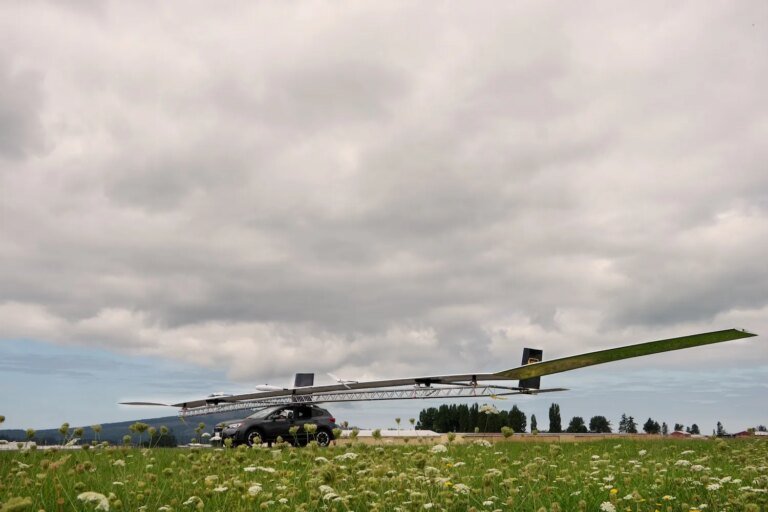Back in the mid-2010s, some of the world’s biggest tech companies were racing to launch lightweight, solar-powered drones to hover above remote areas and beam down internet connectivity. Meta (then called Facebook) and Google, the two companies most heavily investing in the technology at the time, abruptly exited the space following a series of mishaps. In Google’s case, its “Titan” prototype crashed in New Mexico just four minutes after takeoff.
Now, nearly a decade later, a much smaller company is attempting to pick up where those giants left off. This week, Seattle-based startup Radical revealed it has successfully tested a full-scale prototype of its super-thin, solar-powered drone, “Evenstar.” The boomerang-shaped aircraft has a massive wingspan of 120 feet, larger than that of a Boeing 737, but weighs only 240 pounds (less than an average player in the NFL).
And while it’s still a long way from completion, Radical believes its lightweight, solar-powered frame could eventually operate autonomously in the stratosphere for months at a time without interruption. That could make it attractive for weather monitoring, mobile internet connectivity, and aerial surveillance. But Radical will first have to actually get its bizarre drone up in the sky. The most recent test, initially reported by GeekWire, flew only at low altitudes and at speeds just over 15 miles per hour.
“Our goal is to make stratospheric flight as routine as satellite operations, but faster, cheaper, and at higher resolutions,” Radical CEO James Thomas told Popular Science.
‘StratoSats’ are middle ground between satellites and drones
The Evenstar is one example of what Radical calls a “StratoSat.” These are essentially satellite-like, lightweight devices designed to “provide persistent, high-performance infrastructure” in the stratosphere. StratoSats are powered by solar panels mounted on their wings, allowing them to theoretically remain airborne for weeks or even months. And unlike conventional satellites that need to stay in orbit indefinitely, a StratoSat can come back down when it needs to change out whatever it’s carrying onboard.
Given their limited size, that cargo would most likely consist of sensors, cameras, or lightweight mobile telecommunications equipment. The Evenstar, specifically, can carry a 33-pound payload and does so with full autonomous capability. Thomas said the ability to operate autonomously is crucial for ensuring the drone can operate without interruption during long flights.
The Radical CEO told Popular Science the most recent Evenstar test flight occurred in Tillamook, Oregon. The flight was completed autonomously, but a human pilot was available to intervene if necessary. The company told GeekWire that the prototype lifted off from the back of a Subaru before conducting a low-altitude flight. Radical says it hopes to conduct higher altitude tests next year.
Notably, this version wasn’t powered by solar energy but instead relied on a battery. (Radical said it outfitted the drone with a ballast to simulate the added weight the final version would have once equipped with solar panels.) The company did not provide details, either to GeekWire or Popular Science, regarding the flight’s total duration, maximum altitude, or whether the drone experienced any issues.
“The purpose of this flight was to validate Evenstar’s core systems in real-world conditions, including the airframe design, AI controller, telemetry, and communication links,” Thomas told Popular Science. “The test confirmed our design and simulation tools and provided valuable performance data ahead of high-altitude testing.”
Radical is pitching this category of aircraft as a kind of jack-of-all-trades that can fill gaps left by satellites, drones, and conventional planes. In the case of satellites, they’re often capable of providing either wide coverage areas or high-resolution imagery—but not both at the same time. They also move at high speeds, meaning they pass over a given target for only a few minutes each day. The process of getting a satellite up into space is also extremely expensive, something most obviously demonstrated by the estimated $10 billion Elon Musk’s SpaceX has spent to build up its constellation of Starlink satellites in recent years.
Conventional drones address some of those issues but are limited in the amount of time they can spend in the air without refueling. Refueling and running continuous missions can get expensive. All of those drawbacks, Radical argues, is limiting the quality and scale of data that’s being captured from the sky.

“It’s never really made sense to get a better look at something by moving further away from it,” Thomas said in a video posted on X. “It has never made sense to accept a snapshot once every 90 minutes as our view of the world.”
Radical, whose co-founders previously worked on Amazon’s Prime Air drone program, envisions Evenstar one day assisting with long-term wildfire monitoring. Like Google and Meta before it, the company also sees potential in using its lightweight, hovering drone to beam down 5G connectivity to rural or remote areas currently underserved by traditional ISPs. The company’s website also references possible military applications though it didn’t respond to our request for comment on whether it intends to offer its technology for surveillance or law enforcement purposes. The Radical CEO told Popular Science Evenstar is “designed to suit the needs of customers across a range of use cases – both commercially and for the government.”
Related: [A solar-powered Army drone has been flying for 40 days straight]
They also aren’t the only ones racing towards the stratosphere. Airbus has an even lighter (around 165 pounds) solar powered drone called Zephyr, which has already demonstrated it can spend 26 consecutive days in the stratosphere consecutively. US startup Skydweller is pursuing a similar solar powered drone it claims can carry up to 800 pounds of cargo. Radical’s approach is considerably smaller in scale, as is its team. GeekWire notes the Seattle company has just six employees. For now, Thomas said, their path forward is pretty straightforward.
“Our mission is simple.” Thomas said. “Get there [to the stratosphere] stay there.”



